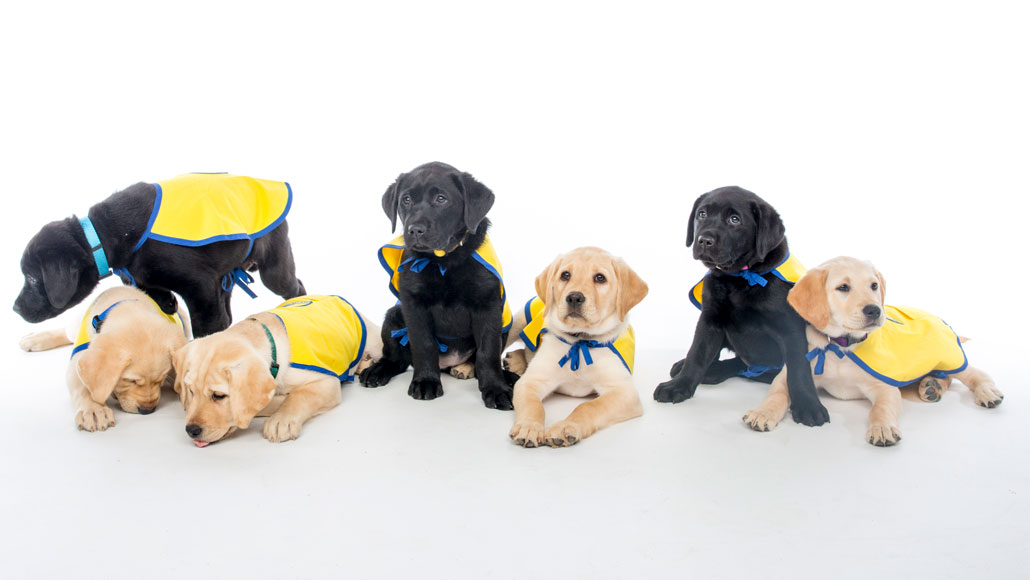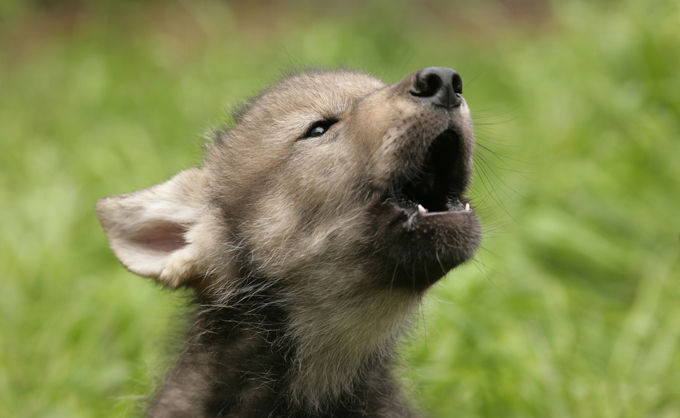Even raised by people, wolves don’t tune into you like your dog
A dog’s brain may be wired to communicate with people from an early age

Researchers investigated when dogs’ ability to understand human gestures begins. To do this, the scientists enlisted 44 puppies from the Canine Companions for Independence program (some pictured here at the Duke Puppy Kindergarten).
Jared Lazarus
Wiggles and wobbles and a powerful pull toward people. That’s what 8-week-old puppies are made of.
From an early age, dogs outpace wolves at engaging with and figuring out cues from humans. It’s true even when the dogs have had less exposure to people. Researchers reported the new findings July 12 in Current Biology.
Compared with human-raised wolf pups, dog puppies that had limited exposure to people were still 30 times as likely to approach a human stranger. And they were five times as likely to approach someone they found familiar. “I think that is by far the clearest result in the paper,” says Clive Wynne. It’s also “powerful and meaningful,” he adds. Wynne is a canine behavioral scientist who did not take part in the study. He works at Arizona State University in Tempe.
Hannah Salomons works at Duke University in Durham, N.C. There she studies how dogs think and learn. During her research, she saw that wolf pups are naturally less entranced by people than dogs are. “When I walked into the [wolf] pen for the first time, they would all just run into the corner and hide,” she says. Over time, most wolf pups came to ignore her. She says they acted “like I was a piece of furniture.”
But dogs can’t seem to resist people. For at least 14,000 years, dogs have been selected for traits that help them live and work with us. This process is called domestication (Doh-MES-ti-KAY-shun). It has changed dogs’ bodies, as well as their brains. In fact, that rewiring of the dogs’ brains makes the pooches innately drawn to people. It may even help them more easily grasp our gestures.
Puppy vs. pup
Dogs respond readily to people, following where a person points, for example. That ability may seem simple, but it’s a skill even chimpanzees — humans’ close relatives — don’t show. Human babies don’t learn how to do it until they’re almost a year old.
Wolves are dogs’ ancestors. But when wolves have been put to the task of following a pointed finger, the results have been mixed. Many scientists think that wolves need explicit training to learn that skill. So scientists haven’t been sure if dogs are born with the ability to follow our gestures. Perhaps, like wolves, they just learn through watching people.
To find out, Salomons and her colleagues showered attention on wolf pups while restricting dog puppies’ access to people. Days after birth, 37 wolves got round-the-clock human attention. Caregivers even slept amid a pile of wolf pups on outdoor mattresses. Meanwhile, 44 retriever puppies stayed with their moms and littermates until they were eight weeks old. They had only brief visits from people.
The researchers then exposed both types of pups to familiar and unfamiliar people and objects. Their memories were tested by hiding treats in their view. A cylinder with food inside challenged a pup’s self-control. (The cylinder was tempting to gnaw on the middle. But the puzzle could only be solved by going around to an open end.) To observe the pups’ response to human gestures, researchers pointed at hidden treats. They also placed a small wooden block next to a hiding spot to draw the eye.
Wolf and dog pups were evenly matched in memory and self-control, the researchers found. But in tasks involving human communication, dogs were better. They were twice as likely as wolves to follow a pointed finger or a wooden block as a clue. Dogs also made twice as much eye contact as wolves did. Dogs met humans’ gaze in four-second bursts compared with wolf pups’ average of 1.47 seconds.

Born for it
Dogs figure out human gestures early, Salomons and her team conclude. This supports the idea that domestication has wired dogs’ brains to communicate with people. Dogs “are born with this readiness to understand that a person would be trying to communicate [with them],” Salomons says. “Wolves didn’t have that tendency. It wouldn’t really occur to them that a person would be trying to help them.”
Wynne thinks the study reveals more about how domestication shaped dogs’ emotions, rather than their thinking. The researchers only worked with wolves willing to approach people. Even so, “it doesn’t strike me as surprising,” he says, that dogs explore objects near people more often. “I think that is most likely to do with the fact that dogs are just generally happier getting close to a person.”
One thing is clear: Domestication has molded dogs into people-seeking missiles. They are drawn to us from the start. The dog pen is all licks, wiggles and eye contact, Salomons says. It’s nothing at all like a cage full of disinterested wolf pups.







